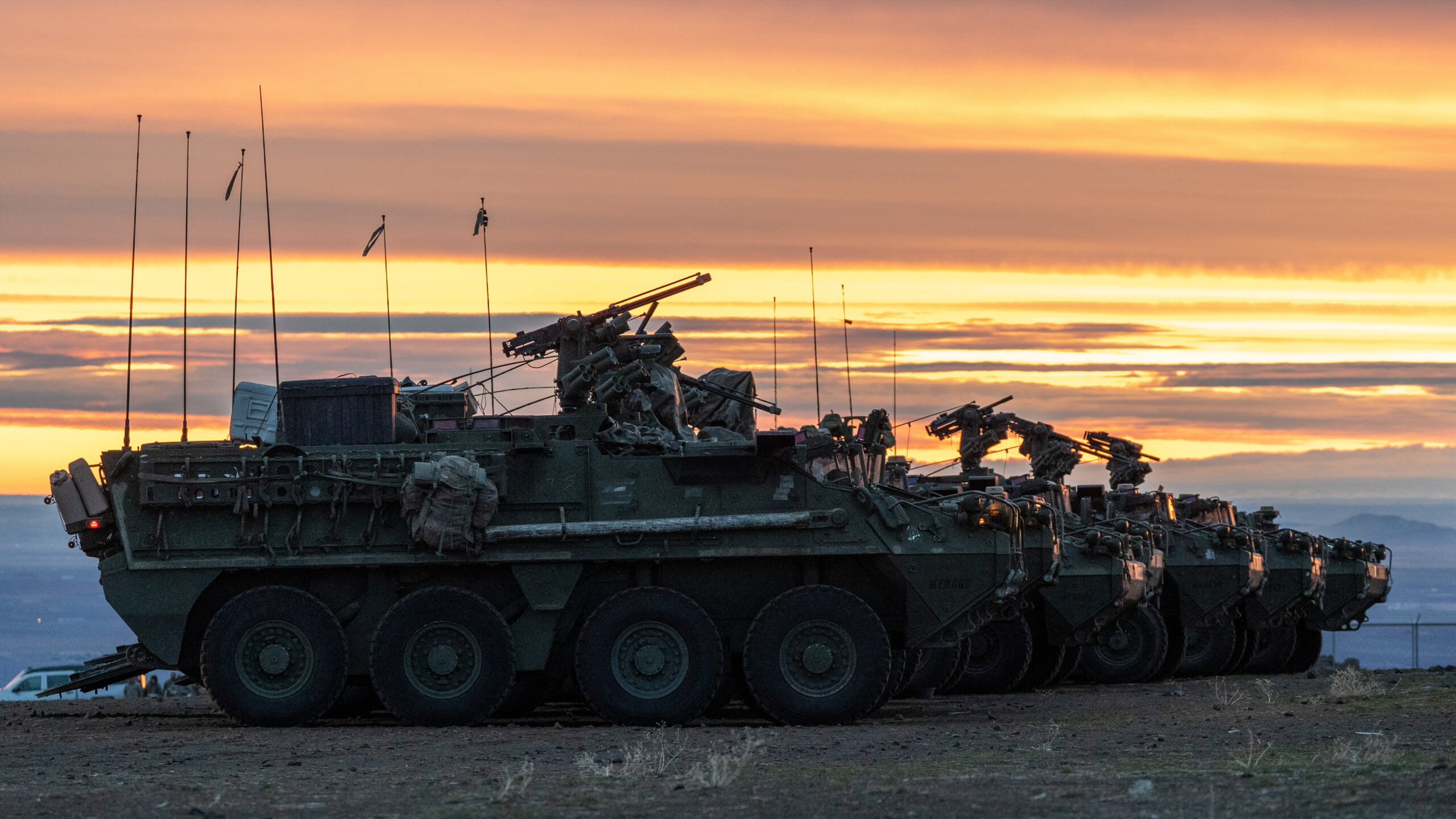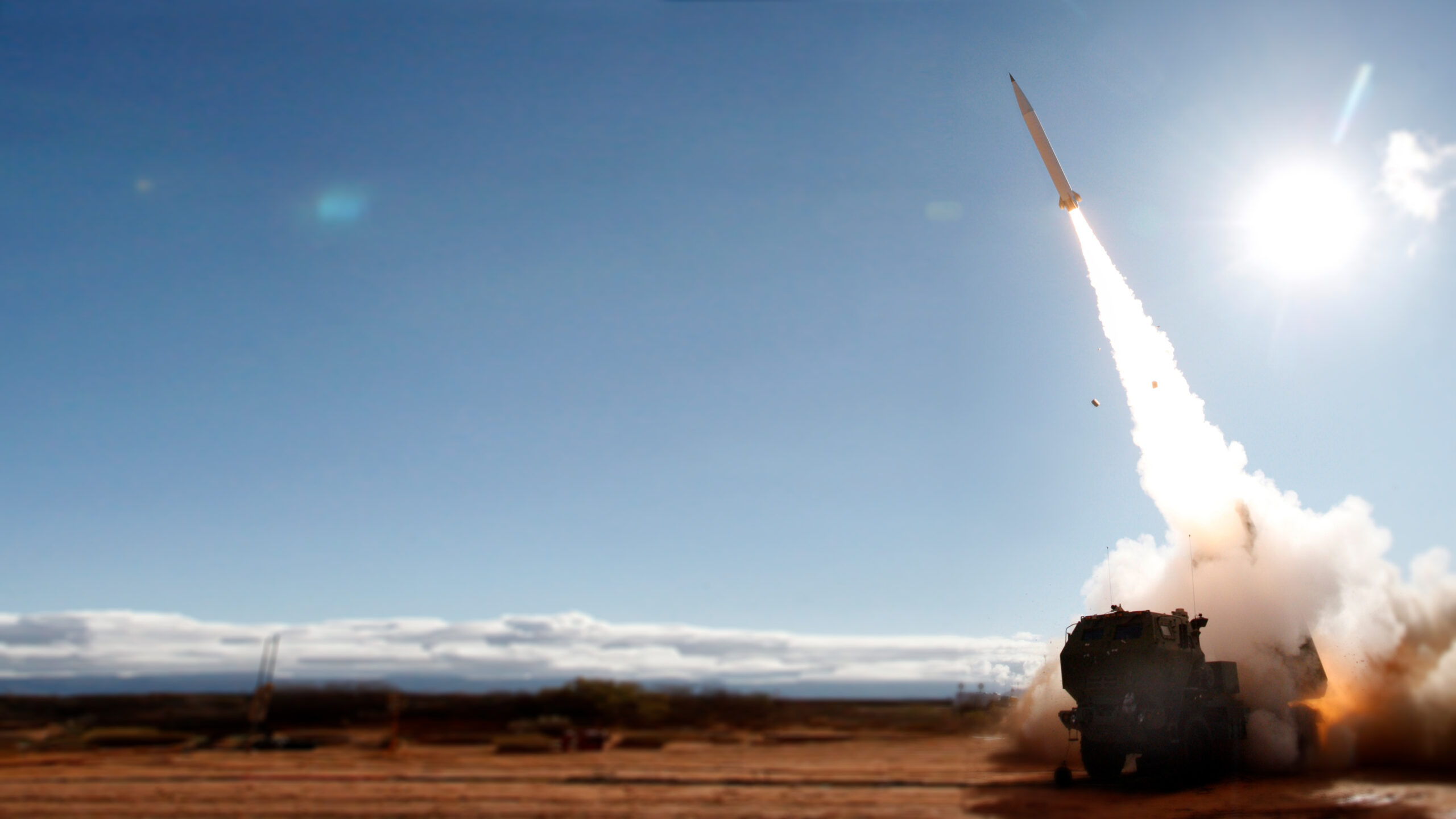
Strykers assigned to 2nd Stryker Brigade Combat Team park in a line before conducting a combined arms blank-fire exercise during exercise Rising Thunder on December 10, 2021 at Yakima Training Center, Wa. (Capt. Cortland Henderson/US Army)
Updated 3/28/22 at 4:28pm ET with comments from Army officials at its budget briefing.
WASHINGTON: The Army will send Congress a budget request of $177.5 billion for fiscal 2023, roughly $2.8 billion more than FY22 appropriations from Congress and $5 billion higher than last year’s budget request.
While the budget request does reduce the Army’s end strength by 12,000 due to recruiting challenges, the service largely seems to have avoided the fiscal “bloodletting” that had been predicted for much of the last year. The service’s request provides steady funding for its core modernization portfolio as a number of programs head into a crucial year, as well as adding millions to bring the Army’s climate strategy to life.
“One of the benefits of this budget is that … we’re able to maintain our momentum. That means that we did not need to look at our modernization accounts as sources of major reductions of any kind, wholesale across the board,” Undersecretary of the Army Gabe Camarillo told reporters ahead of the budget release.
Despite widespread agreement that the Army would end up a bill-payer of a focus shift to the Indo-Pacific, Camarillo insisted that the budget request does not make the Army the background service to the Air Force and Navy, instead allowing the service to focus on its two top priorities.
“We’re able to maintain that high level of readiness to meet current and emerging requirements. And secondly, we’re able to continue our transformation in support of the national defense strategy,” he said.
Related: Here’s the Army’s 24 programs in soldiers’ hands by 2023
The Army’s base budget is $163 billion, up from the $160 billion enacted by Congress in FY22 and up from $154.5 billion last year. The request adds an additional $14.6 billion to the topline for Overseas Operations Costs, which is the extension of Overseas Contingency Operations funds that are transitioning into the base budget.
The growth in the Army’s budget request comes from a $3.2 billion increase above the FY22 enacted for Military Personnel, totaling $69.1 billion, and another $3.6 billion boost over appropriations to $69.7 billion for its total Operations and Maintenance account. Army budget documents said O&M funding provides for 22 combat training center rotations, up from 20 in last year’s budget request, and supports exercises in Europe and the Indo-Pacific.
Perhaps the most surprising aspect of the Army’s budget is a reduction in its Regular Army end-strength to 473,000, down from 485,000 that Congress approved in the omnibus spending package. The request for National Guard and Reserve forces holds steady at FY22 enacted levels of 336,000 and 189,500, respectively, meaning the Army’s total end-strength dips under 1 million to 998,500. Camarillo said that the end-strength reduction “is not a budget-driven decision” but rather “entirely about quality.”
“The genesis of it was really recognizing that if we look ahead to recruiting projections overall for and strength, we weren’t going to be able to get where we needed to be in ‘22 and ‘23, without making some decisions about, you know, changing kind of our standards,” he said, adding that the cuts are temporary and will be restored over the FYDP.
The service’s research and development account total $13.7 billion, up from $12.8 billion in its FY22 request but below the $14.5 billion that Congress gave the service in the FY22 omnibus. The service cut about $1.4 billion in applied research and advanced tech development.
To keep modernization efforts on track, service leaders made the choice to cut the current procurement account to $21.3 billion, down $1.5 billion from the enacted budget, with steep cuts to Abrams, Strykers and aircraft.
The Army budget does not include money to replenish the Army’s supply of Javelins and Stingers that were sent to aid Ukraine in its fight against Russia because the budget was submitted before Russia’s invasion of its neighbor. However, the Army’s acquisition chief said last week that the supplemental spending package passed by Congress alongside the FY22 federal budget included a pot of money that the Army will use to replenish those stocks.
“I expect the first action on that very soon to go back to Congress and say ‘we’d like to spend some of that on Stinger and Javelin,’” said Doug Bush, assistant secretary of the Army for acquisition, logistics and technology, told reporters at a roundtable ahead of the budget release.
However, documents provided by the Army on budget day did not provide the full picture of the service’s requested funding. The Defense Department didn’t release the justification books that provide detailed spending plans and acquisition timelines for the service’s programs, meaning spending breakdowns for the service’s modernization programs were initially unavailable. The Pentagon does plan to release the books in coming weeks.
Investments for the Future Force
The Army’s budget continues to prioritize the service’s core 35 modernization programs, while also spending hundreds of millions on its new climate strategy through investments in electric vehicles and sustainable installations.
The Army was able to protect its modernization programs, as telegraphed by Army leadership for several months, with significant investments in its long-range fires portfolio as programs move closer to prototyping. The Army has pegged FY23 as the year that 24 of its “31+4” modernization programs will reach soldiers’ hands in some stage of prototyping.
“‘[FY] 23 has been a big target year for the Army’s modernization efforts. I think a lot of that’s going to come to fruition,” Bush said. (Again, without access to the j-books, knowing how these programs grow or shrink in coming years is impossible.)
Among the key investments in long-range fires:
- Long-Range Hypersonic Weapon: The Army’ wants $807 million in total research, development and acquisition (RDA) funds for the LRHW, up from $412 million requested in last year’s budget. The LRHW is scheduled to deliver its first rounds to soldiers this year.
- Mid-Range Capability: the service wants RDA funds totaling $409 million, up from the $286 million that Congress appropriated in FY22, which includes funding for flight tests.
- Precision Strike Missile: The service seeks $260 million for its Precision Strike Missile, set to have an early fielding under urgent materiel release in FY23, according to last year’s budget documents.
- Tactical Intelligence Target Access Node: The service’s procurement money also begins the purchase of this system, which the budget overview notes is a “critical link” in long-range fires. Documents provided by the Army upon budget release didn’t include the funding level.
The service also heavily invested in its air defense modernization systems. Its Integrated Air and Missile Defense System received $704 million, with a portion of that to buy 32 systems in FY23, up from 26 that Congress appropriated for FY22. Its Lower-Tier Air and Missile Defense capability received $382 million, up from $328 million in last year’s request.

The Army’s PrSM weapon is seen during a test launch. (Lockheed Martin)
The Army also plans to field a third Multi-Domain Task Force in future years, the request said.
The Army appears to be spending less on RDA for its Maneuver-Short Range Air Defense program, with the Army’s highlights book showing $225 million in spending, down from about $371 million in last year’s request.
The network modernization portfolio received the most funding, with the unified network modernization priority receiving $1.9 billion in funding. The Army budget documents provided Monday didn’t break down funding by cross-functional team.
The Future Attack Reconnaissance Aircraft program requests $979 million, with Bush noting the program received additional funds to make sure it “stayed on its current path” and lined it up with the Improved Turbine Engine Program that fell off-schedule. The budget documents on Monday didn’t specify funding for the Future Long-Range Assault Aircraft, scheduled for down-select this summer.
The Army plans to spend $90.8 million of O&M and RDT&E funding on Project Convergence, its annual sensor to shooter experiment in Yuma, Ariz., according to Maj. Gen. Mark Bennett, director of the Army budget, told reporters at the Monday budget briefing. The event this year is set to include allies. The service’s FY22 budget request asked for $106.8 million.
The service plans to spend $101.8 million on its Arctic strategy, including buying 13 Cold Weather All-Terrain, winterizing of equipment, training exercises in Alaska and cold weather gear, Bennett said.
The Army asked for $2.8 billion for its European Defense Initiative, including a $942 million for “increased presence” in Europe, Bennett said, including the rotation of a division headquarters, armored brigade combat team and other enabler units supported with additional active and mobilized reserve component units.
The budget request will also supply the Army with $725 million to implement the recently-released service climate strategy, Bennett said. Camarillo said the investments would prioritize sustainability initiatives on installations, as well as investments in hybrid and fully electric vehicles.
“There’s very much an operational focus with the investments that we’re making and then particularly making our installations more resilient to the extreme effects of climate change,” Camarillo said.






















